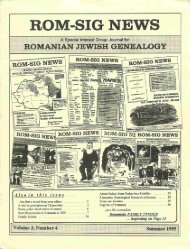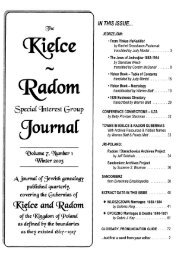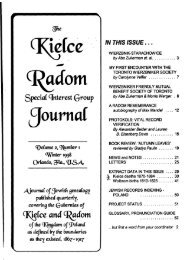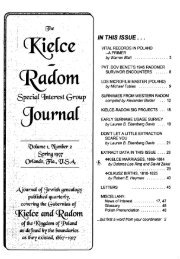THE MEMORIAL BOOK OF PÁPA JEWRY - JewishGen
THE MEMORIAL BOOK OF PÁPA JEWRY - JewishGen
THE MEMORIAL BOOK OF PÁPA JEWRY - JewishGen
Create successful ePaper yourself
Turn your PDF publications into a flip-book with our unique Google optimized e-Paper software.
SOME STATISTICS<br />
The mutual influence of county episcopates founded by King Stephen I and the<br />
Benedictine Order hindered the formation of royal towns where Jews could have settled as<br />
chamber servants.<br />
Count Antal Eszterházy was the first to permit Jewish settlement in Veszprém County in<br />
the first quarter of the 18th century.<br />
The 1736 census mentions 11 Jewish families in Pápa.<br />
In subsequent periods the number of Jews in Pápa was as follows:<br />
In 1740, 73<br />
In 1785-87, 445<br />
In 1830-35, 2645<br />
In 1880, 3550, 24 % of the population<br />
In 1884-94, 3140, 22 % of the population<br />
In 1910, 3076, 15.3 % of the population<br />
In 1941, 2613, 11 % of the population.<br />
The situation of villages surrounding the Pápa community was interesting but sad.<br />
In the village of Tevel in 1830 there were 149 Jews earning their living. They had their<br />
own temple, mikva, rabbi and shochet. Their number gradually decreased to 55, then to 19, and in<br />
1941 there were only 18 left. Most of them moved to Pápa.<br />
In Pápateszér the first census mentions 39 Jews. No one was left.<br />
In Homokbödög in 1880 there were 101. However, in 1941 they numbered only 14.<br />
In Nagydém there was once a large community - the census mentioned 149 Jews at the<br />
time of the War of Independence [1848/49] – which finally decreased to 11.<br />
In the villages closer to Pápa things were not different – in Tapolcafő, where once there<br />
had been 86 Jews, merely 13 were left in 1941.<br />
In Marcaltő even in 1910 there were 37 Jews, while in 1941 only 15.<br />
Statistics clearly prove that the reforms under the rule of Joseph II the "hatted king" [he<br />
was called "the hatted king" because he was never actually crowned as King of Hungary – the<br />
translator] opened a new era in the life of Hungarian Jews as well. Jewish settlement was made<br />
possible by giving the right to change residence.<br />
Taking into account the proportion of Jews in the country, one comes to the conclusion<br />
that Pápa was the largest Jewish settlement in Hungary after Pest and Buda in the beginning of<br />
the 19th century.<br />
84
















